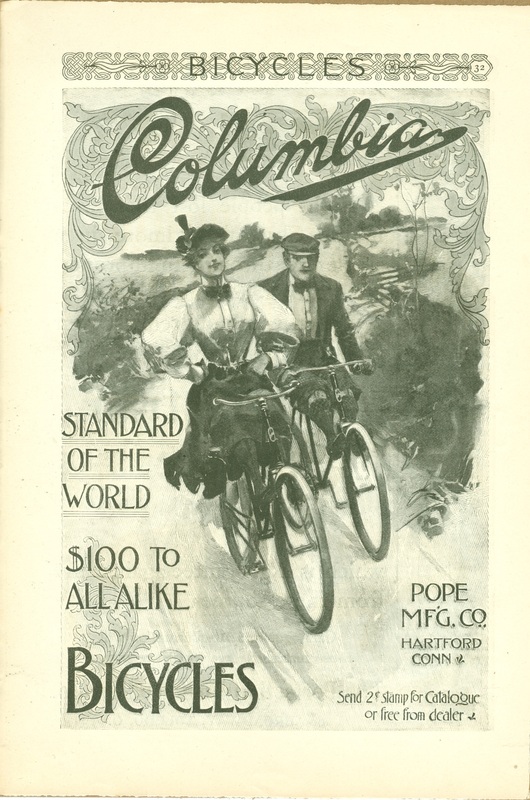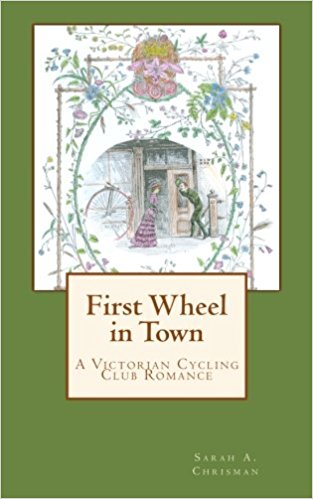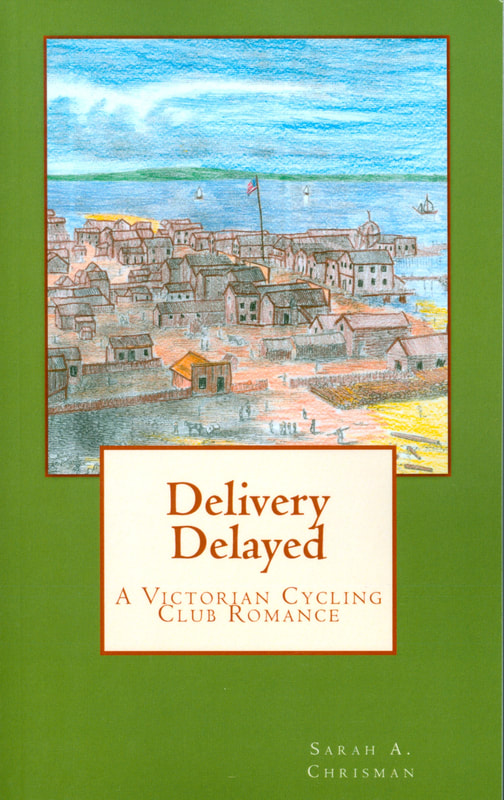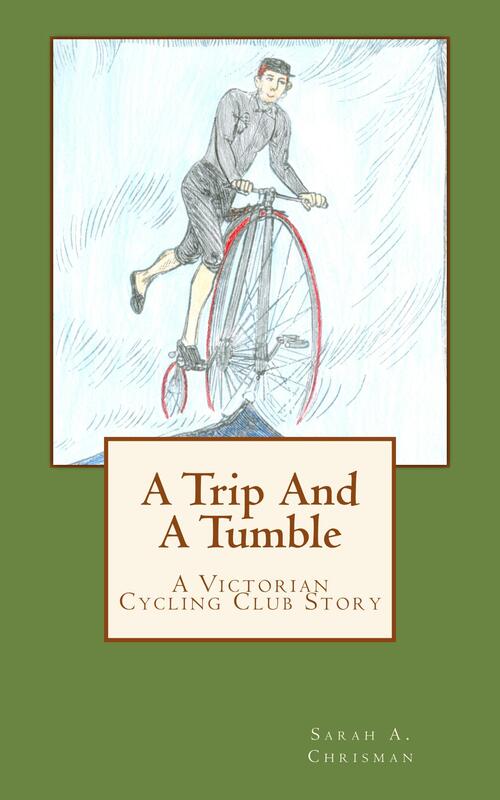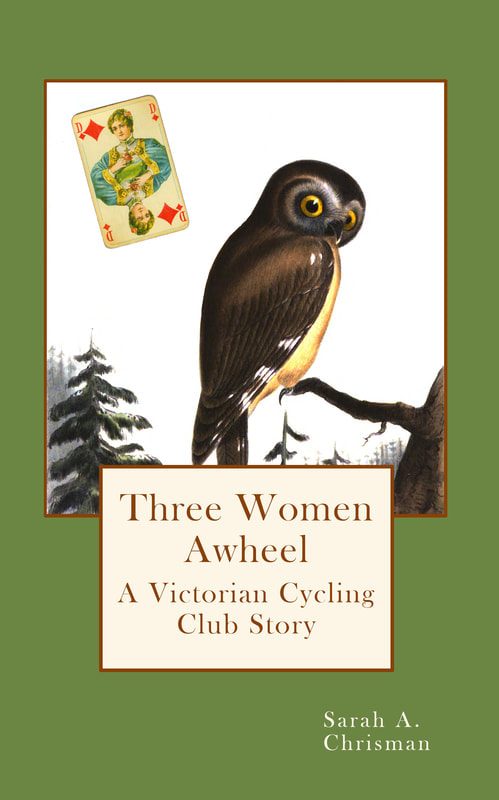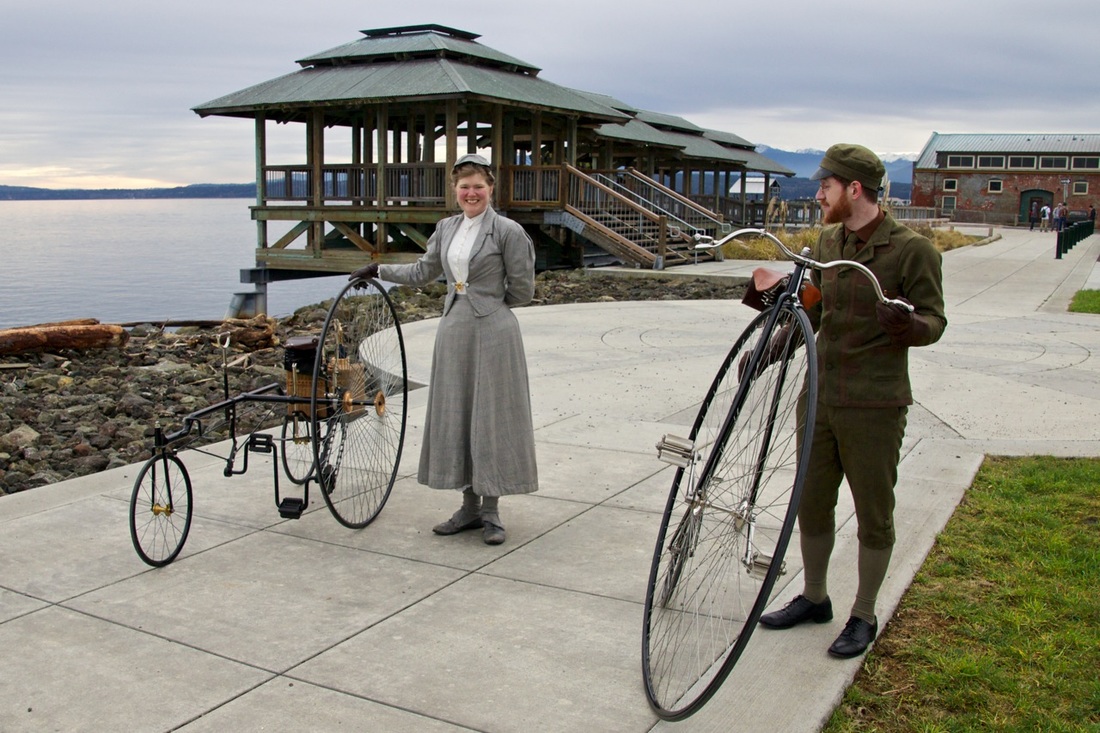Historic Article
A Cycle Show in Little
By Marmaduke Humphrey
Godey’s Magazine, April 1896, pp. 367—378.
By Marmaduke Humphrey
Godey’s Magazine, April 1896, pp. 367—378.
Dante, the Infernal geographer, mapped out Hades in seven circles, or wheels. The modern layman is inclined to build Heaven on two.
The professional poets, however, are notoriously slow in appreciating things. They are still, raving over the beauty of chariots as a means of locomotion, although no one of them would endure such a bone-shaking, time-teasing conveyance for any lady of his love, except his old-fashioned, bat-blind Muse.
But the future conqueror will ride to his triumph on a bicycle, not perched on a clattering chariot or sagging across an uncertain horse.
The peak of Heaven will no longer be deemed a towering and jagged mountain. It will be represented as an ideally level straightaway track, with no trucks or impediments of any kind, and never an ordinance or policeman to check the immortally blissful scorcher. The old idea of Paradise as a drowsy Nirvana, a lazy Lethe-stream of forgetfulness, or a lotos-eatinghouse, is entirely out of date. What we demand is one eternal holiday of good weather, with license to ride early every morning and take our little constitutional. We will trade wings, and harp to boot, for a good ethereal cycle.
What are Declarations of Independence and universal equality, and what are paltry muskets in the hands of insurgents, before the insinuating democracy of a cheap horse, that is swift, yet tractable, for any one of any age or either sex; that requires no feeding, no attendance, and no stable room? Verily, the pursuit of happiness is most reasonably attempted if the pursuer is mounted on the swiftness and comfort of a bicycle.
The effect of the wheel is popularizing the science of dynamics, and various phases of practical mechanics, has not been talked of enough, though it is an infrequent rider indeed that is quite ignorant of the fine points of his machine. At the recent Cycle Show, held with immense success in New York, the exhibitors were fairly amazed at the keen questioning and the minute information of the crowds that paused before their wares.
The bicycle has been of the greatest moment, too, in stimulating invention and commercial enterprises. In a few years its manufacturers have employed stupendous capital, and a horde of Argus-eyed inventors. Their tirelessness and ingenuity, when heaped up in a great exhibition, overwhelm the pilgrim.
When I was younger, and rode a high, wooden wheel, I felt as blissful as Phaeton starting out in the sun-chariot. Then I was taught to scorn the wood-rim for the stouter iron; then that lost its charm before the luxury of hard, little rubber tires. The safety next appeared, at first ridiculous in its strangeness, but soon turning the tables on its high predecessor...
It is, then, with a fiendish ambition... that I have undertaken this all-too-cataloguish account of some of the more important novelties and sundries that will tantalize bicyclists of 1896.
While most of the inventors have devoted themselves mainly to the details, others have attacked the very core of bicyclic philosophy.
The most radical departure of all those exhibited, was one in which the handle-bars are behind the rider. The inventor of this daring innovation claims to have overcome the chief objections of physicians and others to the usual bicycle. It certainly would be hard to get a “bicycle spine” with this wheel, as the application of power is such as to demand an erect position. The inventor predicts a high chest development in consequence, and claims unusual mechanical economy and directness in hill-climbing. The wheel can be made very light, and is available for either sex. One mounts and dismounts in front. It has been proved practicable. Whether it shall prove popular or not, only time can tell...
So irrepressible is human discontent that, in all probability, nothing will ever be made so small that even its diminuitive magnitude will not be complained of. It is not enough that the bicycle occupies hardly a tenth the space of a horse; it is still expected to fit always smaller and smaller crannies. To antidote this grievance, someone has contrived a bicycle that can be doubled on itself, and toted with one hand up a narrow stairway, or along a strait cellarway, or into a passenger elevator; hung up on a hook, stuck behind a door or desk, squeezed into a small bag, and carried as hand-baggage or conveniently checked. The inventor claims rather to have strengthened than weakened the wheel by his bisection, and to have added only a pound to its weight. That it conserves convenience is patent. The next thing due is a pocket bicycle.
The poet has immortalized the “bicycle built for two,” but in its ordinary form of combination-tandem, it has been a sore trial to the sentimental. The back of the fair lady’s neck becomes a torment to loverly eyes when she cannot look round without risking a direful fall. Two considerate inventors have accordingly paid tributed to Dan Cupid with contrivances on which the riders sit side by side. One of these is really a tricycle, the other balances the passengers on two wheels, though its manufacturer avers that people even of the most disproportionate weight can ride it together, or that one person can manage it alone.
All’s fair in love and war; and the inventor of the former double bicycle finds it serviceable for both purposes. When the lovers are through with it, the soldier can fit it with a Maxim Rapid-firing gun. The future of the bicycle militant is full of promise...
The bicyle has commercial ambitions, too, as well as leaning toward courtship and warfare. It is said that one hundred thousand cycles are used in England for parcel delivery and such light work, and they are coming into rapid favor here. Speed, convenience, and economy are combined with all the advantages of delivery by horse and wagon, except the ability to carry goods of great bulk and weight. For messenger service it should instantly supplant the snail-amazing tardiness of puerile pedestrianism, or loitering street-cars. It must come into general play, too, in postal service.
A recent French invention couples two tandems into a fire-engine, with a hose-coil, and a pump worked by the pedals. It has proved its efficiency in practice.
The value of the bicycle in business will doubtless be greatly enhanced by the recent motive applications of petroleum, electricity, etc., but the delights of muscular exercise will always keep something like the present machine in high favor. It is needless to mention the use of the pedal idea in propelling boats and flying-machines.
For purposes of oddity and conspicuousness certain interesting eccentricities have been indulged in, such as the “giraffe” wheel, for advertising purposes; wheels ornamented with precious metals and minerals; the English “bantam,” with a front driver; the unicycle, a reported foreign invention of startling nature, in which the rider sits inside one large wheel; a racing wheel, which enables the rider to bend further forward than ever, till he is almost on his hands; and a multiplication of the tandem till it carries six riders. For this last machine a startling rate of speed is predicted, and it will be highly valuable in pacing races.
The chief activity of the inventor, however, has been the line of improving details. Here it is that one first learns the multitude of faults to be found with the good old wheel.
Aside from the temptation to ride when one is not in fit condition for any muscular exertion, the greatest harm done by the old wheel was due to the saddle - an unyielding, unnatural, dangerous seat with a ridge where a hollow should be, and no conformity to the movement of the hips. A study of the results of the continued use of the old saddle has led eminent authorities to speak of the “murderous future” of the bicycle, and predict all sorts of horrible possibilities for the girls, women, and men devoted to it.
To appease the medical fraternity and consult the comfort and speed of the zealous rider, has been the most earnest effort of the inventors; and if testimonials from distinguished practitioners are any proof, several of these new saddles seem to have found success. One of these is divided into two parts, each side moving with the leg resting on it. Others are filled with air, and various schemes are resorted to for overcoming the inconveniences and elusiveness of air-cushions. Various, too, are the methods of avoiding the ill-arranged pressure of the old ridges. One firm even makes saddles to order from the rider’s impression in modelling clay.
A changeable gear, too, offers many advantages, as a gear that is serviceable under certain conditions is positively dangerous under others. A wheel has been turned out in which there are two gears, changeable without dismounting.
Hope may be likened to a man who goeth forth with an inflated chest and an inflated bicycle tire, and cometh home with the former drooping and the latter punctured. To escape punctures is not easy, but it is well to have a speedy method of repairing them when they occur; for a bicycle is much more convenient as a carrier than as a carriee, especially when one is far from home and repair shops. One plausible appliance is offered that promises to mend a perforation in a minute. A pair of pliers is inserted in the puncture, a circle of patching-cloth pushed through to the bottom of the tire, and a drop of cement squeezed onto the patch. When the tire is not pressed down against it, and the pliers are withdrawn, the patch sticks to the tire and covers the fatal hole. Another scheme is a detachable tire, that can be taken off and put on in a jiffy. A third idea is a clamp that clutches the broken tire on each side of the rent, and permits inflation and use till the emergency is over.
The handle-bar has not failed of attention. To take another mite from the weight of the bicycle, wooden bars and wooden spokes are suggested. They are made of hickory and elm, and are promised to equal the serviceability of wooden rims. In rims, by the way, paper also is being used. To improve the adaptability of one wheel to various riders, handle-bars are now made adjustable. A tempting bit of luxury is a leather cover made for the handle-bars, and the protection of the hands resting on them. A little appliance that makes it possible for a novice to ride with hands off is also of immense convenience.
Roller brakes have been devised to prevent injury to the tire; one of them claims to be automatic and to use the waste power of the wheel for its own stoppage. Various locks, and wall-stands also invite the purchaser and promise to send the sneak-thief packing.
The chain has not been neglected, either. One mechanic would supplant it altogether by using a driving-rod. Another has made a ball-bearing chain that claims to reduce friction to the minimum, and a third has both roller-chain and roller-sprocket, which promise to reduce it still further if possible. A chain is made, too, which can be taken apart and repaired at short notice by the rider. A certain Frenchman would use a band instead of a chain.
A folding attachment that combines two ordinary bicycles temporarily into a three-wheeled tandem, by taking out the fore-wheel of one of the bicycles, has many advantages. It can be carried on one wheel alone, and folded up unobtrusively. Still another appliance results in a four-wheeled tandem, and a third couples the wheels side by side. When baby-seats are added, a family outing is within the reach of all who have the wheels - and the family. For the better comfort and complexion of the bicyclist, one may purchase a folding canopy, to be spread awning-wise at will. It can serve also as an umbrella or as a sail. This is for the sun. The bicycle can skate, too, if an ingenious ice attachment is to be relied on. Handy luggage carriers and a commodious bicycle case add mightily to the usefulness and convenience of the wheel, and make a very factotum out of it.
A collapsible crate that can be folded into a small space, and used again and again, will fill a large gap in the wants of those who ship their bicycles often. There are home-training appliances, too, that make it possible to run the bicycle indoors.
The need for a really effective lamp seems to have been met by a clever application of electricity. The good old lamp that smoked, and smelt, and dripped, and went out with amazing malice at critical moments, will surely be supplanted in some such way as this.
Cyclometers can now be had that will register ten thousand miles and repeat, which will be as alluring a will-o’-the-wisp as a slowly blackening meerschaum pipe.
A speed indicator has been invented, too. Also a combination that indicates both speed and distance travelled. On the same lines is a pacemaker that can be set at any desired rate. While this rate is maintained, it rings a bell. The advantage to record-hunters riding in the dark is manifest.
A rack that serves as a rest, or as a holder of the inverted wheel for cleaning purposes, is of direct value. One of the simplest, yet most useful, appliances is a little, folding rod that enables one to lean the wheel against the atmosphere, as it were, or stand it in the middle of the road, and to save that agonizing search for a fence or curb that is one of the most exasperating inconveniences of the bicycle.
Thus much of a list is long enough to indicate the measure of the vast activity of mind that is centering upon the bicycle. It is not at all a complete list, nor does it say all I should like to say about the things it does include; but if it has suggested to any reader anything that will add to his comfort and devotion to the blessed benefactions of the bicycle, it will not have been at all in vain.
Victorian Cycles
Hand-built 1890's-style bicycles
Interested in a real time machine? Commission one of our 1890s-style custom bicycles! Custom, hand-made steel frames with wooden fenders and chainguards, leather saddles and cork grips. Whether you are interested in a roadster or a racer, we can build you the period bicycle of your dreams.
***
In a seaport town in the late 19th-century Pacific Northwest, a group of friends find themselves drawn together —by chance, by love, and by the marvelous changes their world is undergoing. In the process, they learn that the family we choose can be just as important as the ones we're born into. Join their adventures in
The Tales of Chetzemoka
***
The Wheelman's Joy
Victorian Cycling Poetry and Words About Wheels
Back to Historical Articles Index
Other historic cycling articles:
A Burglar, A Bicycle, and A Storm (Fiction—1897)
A Cycle of the Seasons: A Bicycle Romance in Four Meets (Fiction—1883)
A Cycle Show in Little (1896)
A Header (?) (Poem—1883)
A Modern Love Sung in Ancient Fashion (Poem—1884)
Bicycling and Tricycling (1884)
Cycling for Women (1888)
Cycling's Value As An Exercise (1879)
Is Bicycling Harmful? (1897)
The Evolution of a Sport (1897)
Foreign [Bicycling News] (1884)
A Midwinter-Night's Dream (An homage to Dickens' A Christmas Carol, cycling style —1883)
On Wings of Love (Poem—1884)
Rosalind A Wheel (Fiction—1897)
Snakes in his Wheel (1895)
The Work of Wheelmen for Better Roads (1896)
Woman's Cycle (1896)
An article in Bicycling magazine about us:
"How to Bike Like A Victorian"
http://www.bicycling.com/culture/people/old-doesn-t-mean-bad-modern-conversation-victorian-era-cyclists
A few of Sarah's accounts of our Victorian cycling adventures:
Sarah's trip to the flower fields of the Skagit Valley:
http://www.thisvictorianlife.com/blog/my-recent-trip-to-the-skagit-valley
A Trip to A Lavender Festival:
http://www.thisvictorianlife.com/blog/sneak-peek-into-a-future-book
The Tricycle's Maiden Voyage:
http://www.thisvictorianlife.com/blog/the-tricycles-maiden-voyage
The Chilly Hilly ride:
http://www.thisvictorianlife.com/blog/chilly-hilly
Port Townsend to Port Gamble:
http://www.thisvictorianlife.com/blog/port-gamble-wa
Sarah ALWAYS wears a corset—even while cycling. Here's an excerpt from her book about it:
http://www.thisvictorianlife.com/blog/cycling-in-a-corset-a-short-excerpt-from-victorian-secrets
Rebuttal of an erroneous article:
http://www.thisvictorianlife.com/blog/a-rebuttal-to-a-recent-article
***
Victorian Secrets
|
True Ladies and Proper Gentlemen
|
This
|
***
If you enjoy our website and appreciate what we do,
please consider making a cash donation.
Everything helps, and is appreciated!
Search this website:
***
